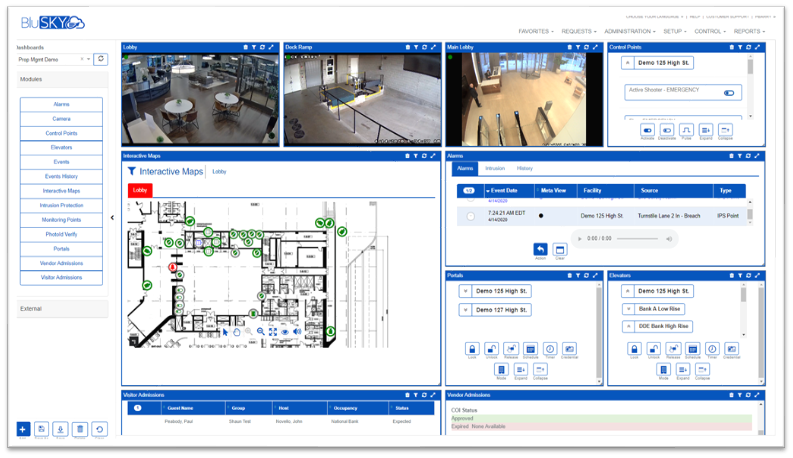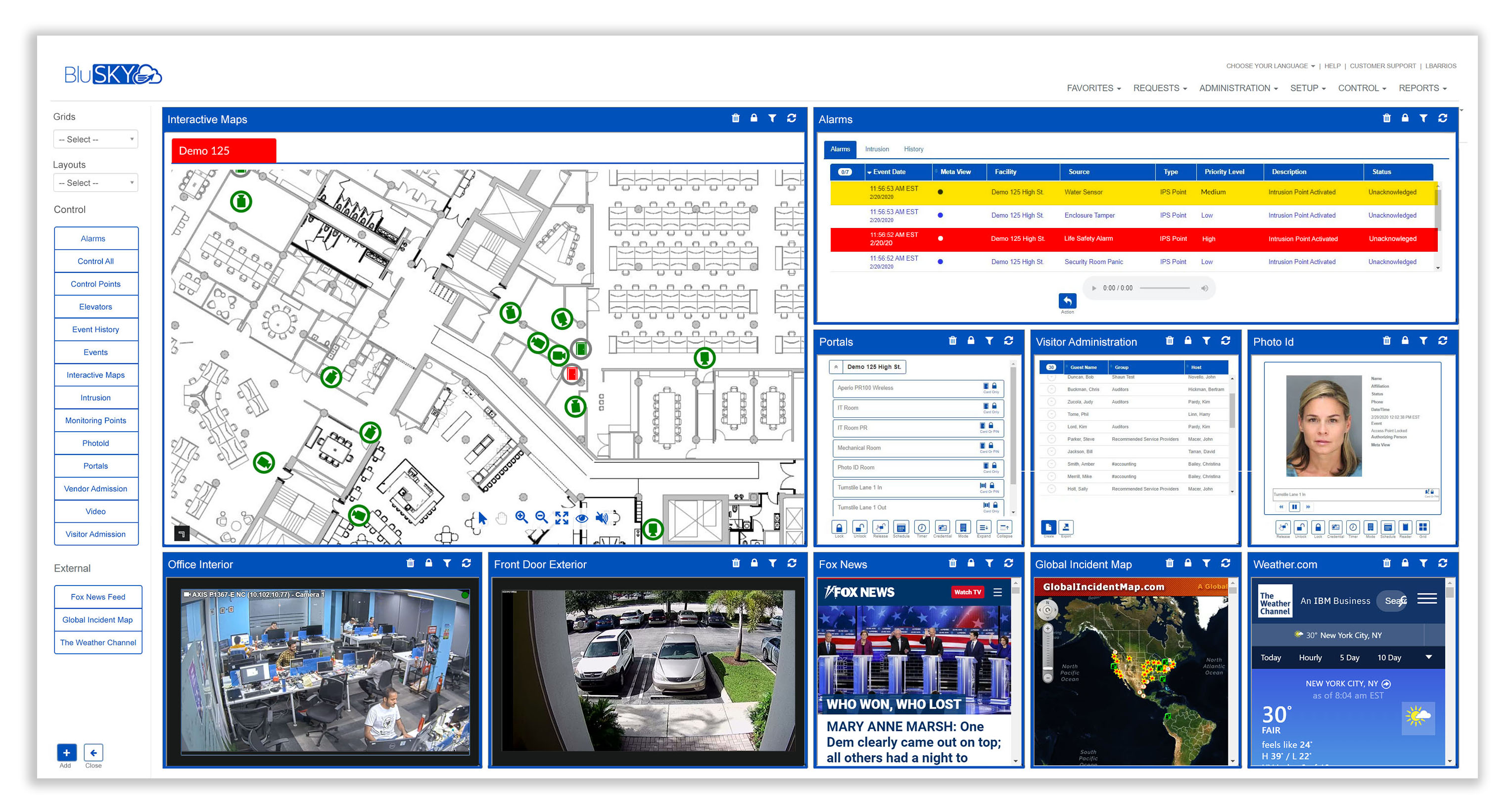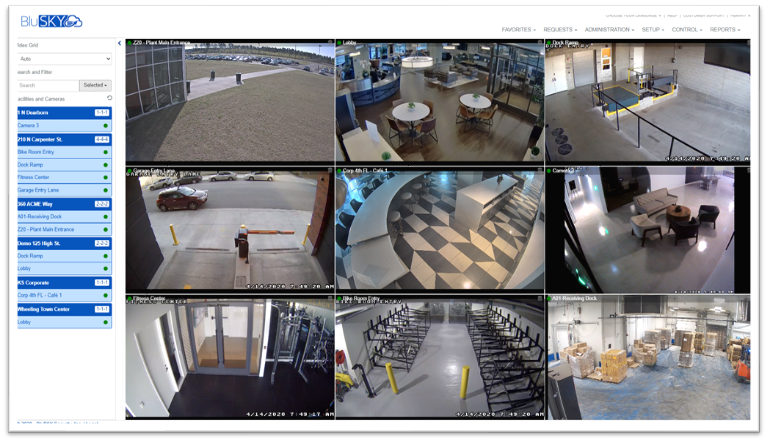April 2020
New Features:
Dashboard
Our newest feature, the BluSKY Dashboard allows you to create custom layouts using any BluSKY module(s), external web pages and RSS feeds. The Dashboard provides a “single pane of glass” to administer, control and monitor your entire security operation. You can also simultaneously run as many Dashboards as you wish. One of its truly unique features is that the Dashboard can display information for any combination of individual BluB0X systems and the number of systems it can support is unlimited. This new feature is at no additional cost, go and give it a try - on any device, anywhere and anytime!
Biggest features include:
- Customize, Save, and Share your dashboard across people, buildings, and/or your entire organization
- Integrate external feeds such as news, weather, and incident reporting


Video Wall and Hybrid Video Integration
You can now see your video from all of your sites connected to BluSKY with different NVRs on a single video wall
Now you can always remain connected by seeing live, recorded and event-based video on any device wherever you are!
Features include:
- Customize, Save, and Share your video layouts
- Include video in any system event- door forced, door held, operator activity, analytics, etc.
- Configure, Manage, and Support all of your cameras and NVRs remotely
- Get 24/7 NVR and camera system health monitoring

Visitor Management
- Automatic check-in when a visitor first swipes their card. This is a great feature to remove a face to face interaction between guests and building staff when combined with sending bar and QR codes to guests via email.
- Added a link in the visitor instance to the visitor request it came from.
Badge Templates
- You can now add a QR code to an employee’s badge. We have seen customers that want to augment building badges with tenant badges, so would like to print QR codes on the back of existing badges, so there is only 1 card to handle.
- You can now choose to have the QR credential be any card type your QR code reader can read. Previously only 26 bit cards were the old card type that could be chosen.
Use-It-Or-LoseIt
This gives the building the ability to see who has not used their credential to access the building in a predetermined amount of time.
There are 5 parts to this feature:
- Portals
- Access Levels
- Access Level Groups
- People-Access tab
- People view list
Overview
In Portals, Access Levels, and Access Level Groups you have the option to set “Access Point Use Analysis Mode”. This can be set to “Use Access Point Setting” or “User Person Setting”, “Do Not Analyze”
- Use Access Point Setting – Use the local Access Point setting for this page
- When this is set you will see an additional field “Access Point Use Analysis Limit” This is where you set how many days a credential can not be used before it shows up in People as a candidate for action, or automatic action is taking place.
- User Person Setting – Use the setting that is set for each person. See People-> Access tab for more details.
- Do Not Analyze – Ignore any analysis for this area. Ex. If this is a bathroom you might not every want to remove access to this space, so do not analyze any credential access for the bathroom
Vendor Management
We have added the ability to notify Vendors and building management when a Vendors COI is going to expire.
- Building will have to create a DL (Distribution List) for this vendor
- In Vendor Management the building will need to assign the created DL in the “COI Notification List”.
For the building to be notified when a COI is going to expire they will need to:
- Create Notification Templates
- Create one for “Vendor CIO Expiration Warning”
- Create one for “Vendor COI Expired”
- Create a Distribution List
- Create Rules.
- Create one “Vendor CIO Expiration Warning”
- Create one for “Vendor COI Expired”
Note: Currently the Notification used to notify the Vendor is the same that is used by the Rules. This means that the same message is sent to both.
Notification Template
You can now add attachments to a notification template. This is particularly great for adding NDA's or surveys for your guests to review and sign/fill out prior to their arrival.
Triggers:
You can now create a trigger when a Portal is “Forced” or “Door Open” Alarms occur.
Controller-Door-Floor Diagnostic
Added new buttons to this tool to “Remove Card Types” and “Remove Persons”. This will enable Integrators to clean up incorrectly added card types to the Mercury controller. If you use these buttons you will remove all the people from the controller, so will need to load them again. Rule of thumb is 20 minutes per 15K people. These 2 buttons are also needed to move systems to the advanced card types. See the knowledge article on why you want to move to the Advanced card types https://knowledge.blub0x.com/Support/Support_Articles/How_to_Create_an_Integrator_Environment/What_is_an_Advanced_Card_Format_and_Why_Do_I_Want_It
Fixes:
Visitor Administration:
- Fixed issue that if multiple visitors with different hosts were checked in at the same time they would swap hosts, which resulted in the wrong host being notified of arrival.
- Addressed issue where visitor badges for a contiguous period beyond 14 days were not getting the correct end date.
Badge Template
- “Guest Company” and “Date Expected” tags were not displaying.
Elevators
- Worked around a KONE issue where the call to the elevator was not handled correctly when from a turnstile.